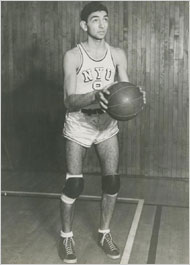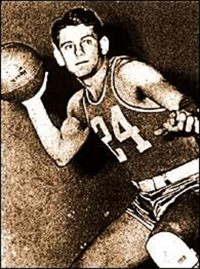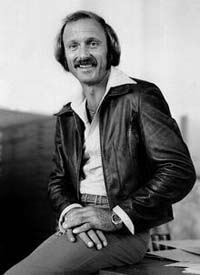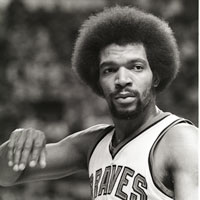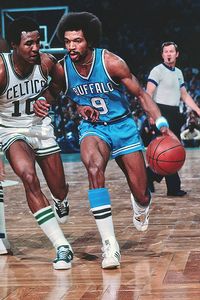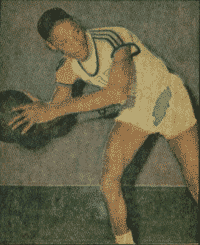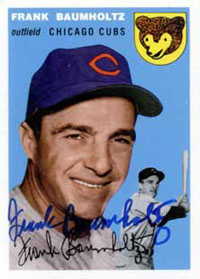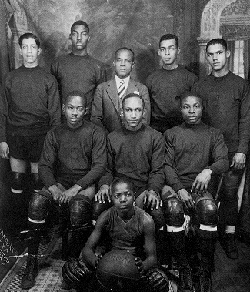CONTENTS
FT Blues – I
FT Blues – II
Ralph Kaplowitz
Lamar Odom
Bad Times for the Lobos
Randy Smith
Sherman White
When the Magic Returned to the Forum
Great Great Lakes Team
New York Rens
Basketball
Snapshots Index
Basketball
Magazine
Golden Rankings Home
|
In baseball, it would be compared to laying down a successful sacrifice. Football's counterpart would be making a chip shot FG. What am I talking about? Making FTs, especially in the final minutes of a close game. Consider three NCAA Tournament Finals in which FT yips cost a team the championship.
- The 2008 Memphis Tigers, while winning an NCAA record 38 games, shot only 62% from the foul line. Coach John Calipari put a confident spin on it: "I'm not worried. We'll make 'em when it counts." So what happened? Cal's boys missed four of five FTs in the final 75 seconds of regulation, opening the door for Kansas to tie with a three-pointer at the buzzer and then win in OT.
- In the 1987 Final, Syracuse made only 11 of 20 FTs and lost to Indiana by one point. Derrick Coleman missed the front end of a one-and-one just before Keith Smart sank the winning basket in the last seconds.
- N. C. State's 54-52 upset in 1983 of Houston's "Fly Slamma Jamma" club on Lorenzo Charles' put back in the last second is one of the most memorable NCAA finals ever. What most people don't remember is that the Cougars went 10-19 at the FT line, missing the front ends of several one-and-ones in the final minutes. If it wasn't already, Jim Valvano's strategy of fouling the worst FT shooters at the end of the game became standard for all coaches.
NBA teams are not exempt from FT-itis.
- In Game One of the 2009 Western Conference Finals, Denver outplayed Los Angeles. However, the Nuggets shot only 23-35 at the FT stripe. LA won 105-103.
- Game Two of the 2009 Eastern Finals will live forever in NBA history because of LeBron James' incredible shot at the buzzer to give Cleveland a one-point win over Orlando. But the heroics would not have happened had not the Magic missed eight FTs (17-25).
A National Association of Basketball Coaches' study found that winning teams score two thirds of their points in the final minute at the foul line. So all coaches stress FT shooting. What are some techniques that work?
Reference: "Sure Points," Alexander Wolff, Sports Illustrated, 3/23/2009
|
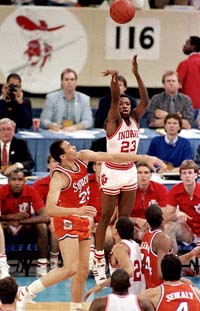
Keith Smart's winning shot
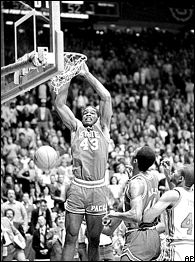
Lorenzo Charles' heroics
|
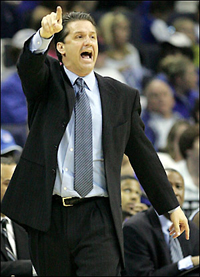
John Calipari
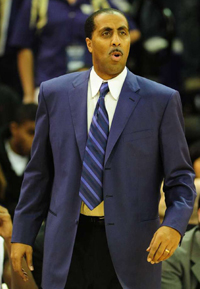
Lorenzo Romar

Denny Crum
|
Basketball coaches take varied approaches to improving players' FT shooting.
- Coach John Calipari was worried that poor foul shooting would cost his Memphis Tigers in the 2008 NCAA Tournament despite his public protestation to the contrary. He tried various approaches.
- He set up a FT shooting tournament to appeal to players' natural competitiveness.
- He even sought advice from old adversary John Chaney of Temple who once threatened to kill him at a post-game press conference.
- Frustrated because nothing seemed to work, Cal even ordered the Tigers to stop practicing FTs once the tournament began. Instead, he had them visualize 10 successful shots before going to sleep.
- When these approaches didn't work, Calipari went back to an old fashioned approach for 2008-9: 100 foul shots per player per practice, every one charted. The Tigers improved their FT% by almost 8 points over 2007-8.
- Sports psychologist Jim Loehr says that the basic fact that should make FT shooting easy – namely, no one is guarding you and you can take your time – is precisely what makes foul shooting difficult for many players. Receiving a pass and letting fly a 3-pointer during the heat of the action is done instinctively based on hundreds of hours of practice. Players can fall into the trap of overthinking FTs. "Your mind can get active and interfere with what is a fine motor skill." Loehr also subscribes to the theory that bad FT shooting is contagious.
- In 2008, Washington ranked last in Division I foul-shooting - 58.6%. The team finished with a losing record. In 2009, the Huskies improved to 64.9%. Head coach Lorenzo Romar attributed the improvement to a drill introduced by assistant Jim Shaw. At the end of practice, all players gather around the key and take turns shooting two FTs each. If the group doesn't make at least 19 of the 26 shots, everyone starts over. The target started at 17 in October, and the team took up to 45 minutes to complete the drill. By the end of the season, they routinely finished in 10 minutes. Romar: "It builds up mental toughness over time."
- A classic approach is the one employed by Denny Crum in his long tenure at Louisville. In 1974-5, he required every Cardinal to make 10 straight FTs before he could leave practice. No one was better than G Terry Howard. He was 28 for 28 for the season when Louisville played UCLA in the 1975 semifinals. In the last minute of OT with Louisville in possession leading by one, Coach John Wooden told his players not to foul Howard but one of them did. Twelve years before the three-point shot, things looked bleak for the Bruins as Howard shot a one-and-one. But he missed the first one, UCLA rebounded, and with two seconds left Richard Washington hit a baseline jumper for the victory. Since the Cardinals had to play in the consolation game, Howard hit 87 in a row at practice the next day. Pressure. Go figure.
Reference: "Sure Points," Alexander Wolff, Sports Illustrated, 3/23/2009
Back to Top
|
|
|
|
Ralph Kaplowitz, who played in the very first NBA game in 1946, died on February 2, 2009 in Queens NY at age 89.
- A 6'2" G from the Bronx, Ralph starred at DeWitt Clinton High School.
- He attended New York University. After playing freshman ball, he joined the varsity in 1939-40. The second leading on the Violets, he was named to Collier's Magazine All-American team. He did lead the squad in scoring in 1940-1 and was named captain for 1941-2. However, Ralph entered the Army before the season.
- After the War, he returned to NYU to complete his degree in education. He then played one season for the Philadelphia SPHAs in the American Basketball League.
- In August 1946, Ned Irish, who ran Madison Square Garden, called Kaplowitz to invite him to play for the Knicks, Irish's entry in the new National Basketball Association. Ralph signed a one-year contract worth $6,500.
- Ralph was a starting G in that first NBA game in Toronto.
- Kaplowitz was not the only Jewish player on the Knicks. There was also Ossie Schectman, Sonny Hertzberg, Jake Weber, and Leo Gottlieb. This caused a problem as the season progressed as fans on the road and even at MSG showered the team with anti-Semitic catcalls.
- Midway through the season, Ralph was traded to the Philadelphia Warriors, who were owned and coached by Eddie Gottlieb. The Warriors won the first NBA championship, defeating the Chicago Stags 4-1 in the Finals.
- The Knicks traded other Jewish players until only Hertzberg was left on the roster when the inaugural season ended. And even he was traded during the off-season.
- Kaplowitz played the 1947-8 season for Philadelphia, which made the playoffs again.
- Ralph returned to the ABL for two seasons, retiring after the 1949-50 campaign at age 31.
|
|
Lamar Odom of the Los Angeles Lakers has hardly had a smooth ride to the NBA.
- His father was addicted to heroin, and his mother died of cancer when he was 12.
- Odom attended three high schools and had his first college scholarship revoked before the fall semester of his freshman year.
- He became the subject of three NCAA investigations.
- Lamar was drafted by the worst franchise in sports, the Los Angeles Clippers.
- He violated the NBA's antidrug policy twice within eight months.
- After finally getting his life together, he attended his aunt's funeral in New York City and wound up burying his 6 1/2 month old son and getting robbed at gunpoint.
Through it all, the 29-year-old 6'10" Odom has exhibited the basketball skills that made him so desirable for colleges that they violated the rules to get him. Some describe him as "a point guard in a power forward's body, long enough to anchor the post but coordinated enough to lead the break." He can literally play every position on the court offensively and defensively.
In high school, Lamar preferred to emulate his favorite player, Michael Jordan, by dishing rather than dunking. When scouts would come to see him play at Christ the King in Queens NY, he'd pass up shots to set up teammates so they would look good. He played his senior year at St. Thomas More, a boarding school in Connecticut. He was named Parade magazine's high school Player of the Year for 1997.
He originally signed with UNLV and enrolled in summer school. However, an investigation of various charges against the basketball program found that he had been paid $5,600 by a booster. The coach was fired and UNLV placed on probation. Lamar transferred to Rhode Island and, after sitting out the 1997-8 season, played one year for Jim Harrick. Averaging 17.6 ppg, he led RIU to its first Atlantic 10 title.
He declared for the NBA draft but got cold feet. However, in 1998, college players could not withdraw from the draft and retain their college eligibility. He was taken #4 by the infamous Clippers. He hired a tennis agent who had never represented a basketball player before. However, Odom chose well, as Jeff Schwartz is now considered one of the top NBA agents. He made the NBA All-Rookie first team. In his third year with LA, he was suspended for smoking marijuana.
When his Clippers' contract expired, he played for the Miami Heat in 2003-4. He helped the team make the playoffs in Dwayne Wade's rookie year. However, in the off-season he was traded to the Lakers with two other players for Shaquille O'Neal. He played on the disappointing U.S. Olympic team that won the bronze medal in 2004.
After Odom's first season with the Lakers, during which he missed considerable time with a shoulder injury and the team didn't make the playoffs for only the fifth time in history, the club brought Phil Jackson back out of retirement. One of his goals was to mold Odom into a Scotty Pippen-type player who would complement superstar Kobe Bryant. Lamar came into his own in 2008 after Pao Gasol was acquired, helping the Lakers push all the way to the NBA Finals.
During the 2008-9 season, Lamar came off the bench for the first time since 9th grade. Initially, he wondered if Coach Phil Jackson had lost his mind. But he adjusted to his new role and, as this is written, the Lakers are back in the Finals.
Lamar lives with his girlfriend and their 10-year-old daughter and 7-year-old son. They lost an infant son who died of SIDS in 2006. He is considered the most popular Laker among his teammates and with the fans. His unselfishness on the court carries over to a spirit of generosity off of it as well.
|
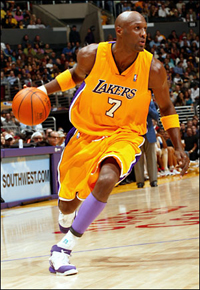
Lamar Odom
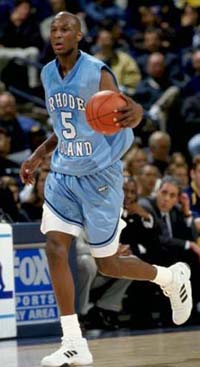
Odom at Rhode Island
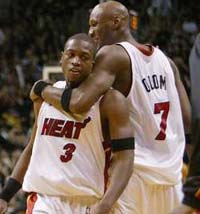
Odom and Dwayne Wade
Back to Top
|
Reference: "Another Sunny Day in Lamar's L.A.," Lee Jenkins, Sports Illustrated 3/23/2009
Back to Top
|
Just as the 1979-80 basketball season was starting, the University of New Mexico was hit by a scandal that nearly destroyed its basketball program.
- On December 1, 1979, New Mexico dismissed head basketball coach Norm Ellenberger and his assistant, Manny Goldstein, for involvement in the forgery of G Craig Gilbert's JC transcript. Gilbert, who didn't know about the forgery, was suspended. Evidence had been uncovered as a side effect of FBI wiretaps that had been installed to investigate gambling activities in the area.
- Six days later, five other UNM players were declared ineligible because their transcript showed three hours of credit from a summer course that none of them had actually taken. A sixth player who claimed that he did take the course was suspended pending further investigation.
- The course, "Current Problems and Principles in Coaching Athletics," was an "extension" class administered by Ottawa (KS) University but taught in the Los Angeles area.
- The five players signed a press release stating that they had no knowledge of how they became enrolled in the course and were unaware that they had received credit for it. The player who claimed to have taken it couldn't remember where in the L.A. area the class had been held.
- The course was in fact conducted by Earle Durley, a PE instructor at Valley College, in a colleague's garage which was converted to a den. Durley testified that persons attended the courses, took the tests, and got grades using the basketball players' names. However, no one in Durley's class bore any resemblance to the players.
- Newspaper reporters, smelling blood in the water, began their own snooping. The Albuquerque Journal uncovered a series of loans to Lobo basketball playes from Citzens Bank in Albuquerque. In December 1976, three players received $2,000 each, and in November 1977, three others got $1,700 apiece. Former Lobo player Mike Gallagher told the Journal that loans were "a regular part of playing basketball at New Mexico for years."
Faced with the sudden loss of seven players, interim coach Charlie Harrison put together a ragtag team to play the remaining schedule, starting at archrival New Mexico State on December 8.
- With only four scholarship players left, the Lobos recruited walk-ons including two QBs from the football team and even a student trainer.
- Surprisingly, NM lost to NMS only 68-58.
- The team finished 6-22 that season.
- Gary Colson was hired to get the program back on track after "Lobo-gate." It took four years to return to post-season. Colson coached eight seasons before being fired.
Ultimately, the NCAA uncovered 57 rules violations. In addition, Ellenberger was indicted by the Federal Government on mail-fraud charges but was later cleared. Also indicted by the state on 22 counts of fraud and filing false public vouchers, he was convicted on 21 counts in July 1980. At the sentencing, the judge imposed a lenient sentence of a year's unsupervised probation. Goldstein, who was identified as having forged many of the fake transcripts, was convicted on one count of fraud and one count of filing a false public voucher. He was fined $1,368 and ordered to repay $648 to the university.
Ellenberger, who compiled a 134-62 record with two WAC championships in seven years at UNM, coached in the CBA for several years before Don Haskins hired him as an assistant at UTEP. Norm then served ten years as an assistant to Bobby Knight at Indiana before ending his career as an assistant with the Chicago Bulls. One of Stormin' Norman's best players at UNM was Michael Cooper (1976-8), who made a name for himself as the defensive stopper during the Lakers three-peat in the late 80s.
Reference: "New Mexico: More Tremors," John Panacek, Sports Illustrated, 12/17/1979 |
|
|
|
Randy Smith was not drafted until the seventh round by the Buffalo Braves in 1971.
- Braves' GM Eddie Donovan admitted he drafted Smith only because he had become a local legend at Buffalo State College.
- Randy earned All-American honors in three different sports: basketball, soccer, and track.
- In soccer, he came within three goals of outscoring the opposition for the entir season.
- His junior year, he averaged 30 ppg in basketball.
- In high school on Long Island, Randy had set a state high jump record of 6'6".
- Despite spending the night in jail because of a misunderstanding with a Philadelphia policeman, Smith finished second in two events at the Penn Relays.
- Smith helped Buff State to three straight conference championships and a berth in the 1970 Division III Final Four.
- Donovan admitted later that he didn't expect Smith to make the team. Instead, Randy played 12 NBA seasons "largely because of his freakish natural athletic ability."
- Despite his 6'3" height, Smith played F because of his leaping ability. He averaged 13.4 ppg. He also became a respected defender whose quickness allowed him to guard
- He had never been out of the lineup because of injury all through high school and college. Despite the factc that he never even had his ankles taped, he played a record 906 straight NBA games, ending only when the San Diego Clippers (the team name after the Braves relocated in 1978) waived him in 1983. [His consecutive games streak has been broken by A. C. Green with 1,192.]
- Smith was MVP of the 1978 All-Star Game when he scored 27, grabbed seven RB, and recorded six assists.
- "Randy may have been the fastest player in the NBA at his peak, and he was one of the really great guards. He could hold his own anybody." This was the tribute of former Braves owner Paul Snyder when Randy died of a heart attack at age 60 following a workout in June 2009.
|
|
Sherman White Had It Made
Sherman White led the NCAA in scoring in 1950-1 with a 27.7 point average for Long Island University. The New York Knicks planned to make him their first-round draft choice using their territorial choice. Instead, White spent the next NBA season in prison. What happened?
- During the 1949-50 season, three LIU players, senior Eddie Gard, the ringleader, Adolph Bigos, and Dick Fuertado received money from New York gambler Salvatore Sollazzo to shave points.
- White became suspicious during the rigged game. A nine-point favorite over North Carolina State, the Blackbirds lost 55-52. He almost got into a fistfight with Gard after the game. Uncharacteristically, the playmaker's passes were at White's feet.
- Soon afterward, Gard let Sherman in on what was happening and invited him to join the conspiracy. Eddie used the argument that they would still win the games, just not enough to cover the spread. Although his New Jersey family was poor, White admitted many years later that he joined to be "one of the guys." In fact, he spent very little of the $5,500 he received during the 1950-1 season, stashing most of it away in an envelope in his room.
- White helped shave points in two games later in the 1950 season, both lopsided losses: 83-65 to Cincinnati and then 80-52 to Syracuse in the first round of the N.I.T. at Madison Square Garden when that tournament was more prestigious than the NCAA tournament.
- The next season, LIU won four games at the Garden while shaving points in the betting line. For example, they beat Kansas State 60-59 on December 2 in a game they were favored by 7.5. As White later explained, it was easier and less obvious to shave on D than O. "You had to turn your head or you had to slide and let a guy go n to make a basket. But we knew it was getting too risky to continue. We were hearing too many rumors."
- White, Bigos, and a new conspirator, LeRoy Smith, decided to play it straight against Duquesne in the Garden despite urging by Gard on behalf of Sollazzo. The three combined for 64 points as LIU won 84-52, costing Sollazzo a reported $30,000.
- The next day, two former Manhattan players, Hank Poppe and Jack Byrnes, and three gamblers were arrested for trying to fix a Manhattan-DePaul game. In the ensuing weeks, White noticed he was being followed as he drove home to Englewood NJ.
- On February 18, three CCNY players were arrested. Finally, on the 20th, two New York detectives arrested White. "I knew it was a matter of time," said Sherman. Confronted by Gard and Bigos, who had admitted their guilt, White caved in.
- On November 19, 1951, White was sentenced to a year in jail along with Gard. Sollazzo received a 12-year sentence. Sherman served eight months and 24 days.
- The NBA banned him from league for life. The Knicks had been preparing a $12-13,000 offer to him.
Reference: "When Sherman White Threw It All Away," Dave Anderson,
New York Times, March 22, 1998
|
|
|
When the Magic Returned to the Forum
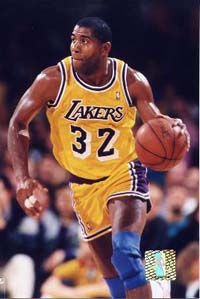
Magic Johnson Before His First Retirement
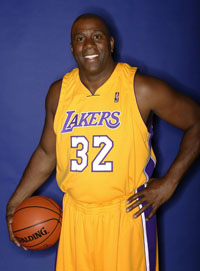
Magic Johnson After His Return to the Court
Back to Top
|
He was 4 1/2 years older and 30 lb heavier than when he last appeared in an NBA game. But he still instilled electricity in the crowd when he reported to the scorer's table in the Great Western Forum on January 29, 1996 to take the court again for the Los Angeles Lakers against the Golden State Warriors.
- After a 12-year Hall of Fame career with the Lakers, 31-year-old Earvin "Magic" Johnson had shocked the sports world on November 7, 1991, when he announced that he was HIV positive. Given the limited medical knowledge about his condition at the time, he retired from the game for the sake of his own health and the peace of mind of his peers. Some of his teammates wept because they figured he would not live long.
- Magic did play on the Dream Team at the 1992 Barcelona Olympics, but when he tried a comeback that fall, the fears of outspoken players forced him to back off.
- Johnson took over as coach of the Lakers for the second half of the 1994 season but "quit after finding it was harder to communicate with the modern player while wearing a suit rather than a Laker uniform."
- During the next four years, AIDs research and AIDs education progressed to the point where Magic not only was still alive but also healthy enough to play basketball again. The Center for Disease Control set the chance of a basketball player contracting AIDs from incidental touching at 1 in 85 million. Gone also was the notion that vigorous participation in athletics would somehow weaken Johnson and accelerate the onset of AIDs. "They said basketball would kill me. Well, not playing basketball was killing me."
- Before he could be reinstated to the roster, Magic had to sell the 5% of the team he had purchased from owner Jerry Buss.
Johnson's journey to reactivation began when he worked out with the Lakers, "a young and talented but leaderless team."
- First, guards Nick Van Exel and Eddie Jones, then coach Del Harris, and finally executive VP Jerry West "put a full-court press on Johnson, asking him to return, telling him that he was just what the team needed."
- When his wife Cookie gave her blessing, Magic signed a contract for $2.5 million for a half-season of play. At the news conference, Johnson claimed he was "five steps slower" and joked, "I'll be doing my Larry Bird imitation now."
- Magic's return gave a shot in the arm to the entire Los Angeles area which had experienced a devastating earthquake, a riot, and the O. J. Simpson trial since Magic had retired.
- The Forum was sold out for only the second time all season. #1 Laker fan Jack Nicholson was away making a movie but other stars, such as Rob Lowe, attended.
- The crowd rose as one and cheered when Harris put Johnson in to replace Elden Campbell with 2:21 left in Q1. After missing his first shot, Magic quickly got an assist, a right-handed running shot, a left-handed hook and then he faked a pass and moved past Latrell Sprewell for a layup.
- When he entered the game, the Lakers led by only 3. When he left, the margin was 17. He played some more in the second half and his example of unselfish play caused the Lakers to register an NBA season-high 44 assists for the game.
Johnson played in 32 games in his final half-season before permanent retirement. His per-game averages were:
29.9 min, 6.9 assists, 14.6 pts., 5.7 rebs.
LA finished second in the Pacific Division, 11 games behind the Seattle Supersonics. The fourth-seeded Lakers were eliminated in the first round of the playoffs in four games by the Houston Rockets.
Reference: "As If by Magic," Steve Wulf, Time, February 12, 1996 |
|
During each of the world wars, the Great Lakes Naval Training Station in Chicago fielded football, basketball, and baseball teams that were among the best in the country. The focus of this article is the 1941-2 Great Lakes basketball squad.
- The team was coached by the base's athletic officer Lt. James Cook, a member of the 1918 Great Lakes cage team after earning three letters at De Pauw University (IN). Cook later coached college teams for over a decade.
- Cook assembled an all-star roster (all white, of course).
- Bob Calihan, former Detroit U. all-American
- Forrest Anderson, all-conference at Stanford
- Bill Menke, all-time leading scorer at Indiana and sparkplug on the 1940 NCAA champions
- Ernie Andres, another Indiana all-American who set the Big Ten record with 31 points in one game
- Frank Baumholtz, all-American at Ohio U. who had earned the MVP award in the NIT the year before
- Jim Currie, a star at Northwestern
- Lee Huber, Kentucky all-American
- John Lobsiger, all-conference at Missouri
- George Rung, star at Miami (OH)
- Jim Van Orsdel, another Miami star
- Bob White of Dartmouth's 1940 Ivy League champions
- The Great Lakes team finished 31-5 with victories over Notre Dame, Indiana, Butler, Purdue, Northwestern, Marquette, Wisconsin, and numerous Army and Navy base teams.
- The sterling record was achieved despite limited practice time – about an hour a day.
The Great Lakes executive officer, Captain T. Dewitt Carr, praised the team in a letter after the season.
Never for one moment have you and the rest of the boys on the team been anything but the finest examples of Navy manhood. On trains, in hotel lobbies, at luncheons and on the basketball court your conduct has been so splendid that the entire Navy recognized you and your team as the best recruiting "poster" in the Ninth Naval District.
You carried the Navy story to colleges and towns and you did it in the Navy way. You ignored inconveniences, you fought harder when you were tired, and you asked for no special privileges during all the time you were doing a double job for your Navy.
Enlistments increased because of your many trips, the Navy Relief Fund received thousands of dollars from our share of gate receipts, and you helped knot recruit morale into one spirited whole with your games at home.
True, five games were lost, but only five out of 36. In Navy terms, losing five while sinking 31 of the enemy ships means complete victory.
Frank Baumholtz (5'10" 170 lb) became the first two-sport professional athlete. He played one season for the Cleveland Rebels of the Basketball Association of America, the predecessor of the NBA. Frank had a longer career as an outfielder in baseball: Cincinnati Reds (1947-9), Chicago Cubs (1951-5), and Philadelphia Phillies (1956-7).
Reference: "Star Tars," Time, January 26, 1942 |
|
|
|
|
The New York Renaissance were a team of black players who, like the Harlem Globetrotters (founded 1927) traveled across the country playing all comers from 1923 until 1948.
- Founded and coached by Robert J. Douglas, considered the Father of Black Basketball, the team took its curious nickname from the Renaissance Casino Ballroom which was in Harlem not far from the famous Cotton Club.
- The Rens played their home games in the Ballroom on Sundays and holidays, often before crowds of 1,000. Because the floor was waxed for the dancing before and after the games, there was little running and jumping during the contests. When the Depression ruined the dance-hall business, the Rens went on the road for 18 years.
- They were considered the best basketball team of the 1920s. Their white rivals, the Original Celtics (founded 1918 in New York), drew their largest crowds against the Rens. In fact, the Celtics refused to join the American Basketball Association in 1925 because the league rejected the Rens.
- As good as they were in the '20s, the Rens were even better in the '30s. The Celtics, on the other hand, went into decline. Nevertheless, the two teams drew upwards of 15,000 for games in the Midwest and New York.
- In 1932-3, the Rens won 88 in a row, still a professional record. Their 1934 season mark was 121-19; a year later, 128-11. In 1939, they won the "professional world championship" in a three-day tournament in Chicago.
- It has been calculated that, since they started counting in 1927, the Rens won 2,318 and lost 381 (.859). A player who competed opposite both the Rens and the Original Celtics, John Wooden of the Kautsky Athletic Club (yes, that John Wooden) said, "The Rens were definitely better. They were as good a team as you would find in that era; as good as anyone." Both teams have been inducted into the National Basketball Hall of Fame as units.
Eschewing the vaudeville show provided by the Globetrotters for serious basketball, the Rens fielded the same lineup from 1931-1936: the Magnificent Seven.
- Clarence "Fat" Jenkins – lightning quick 5'6" lefty who, as captain, ran the O.
- Bill Yancey – "one of the greatest shooters I ever saw" (Wooden); also played SS in the Negro Baseball League.
- James "Pappy" Ricks – considered the star of the team, "one of the most natural shooters the world has ever known" (Douglas).
- Charles "Tarzan" Cooper – at 6'3" 220, won almost every tap in an era when a center jump followed every basket; inducted into the HOF in 1976 as an individual, the third black player so recognized at that time.
- Eyre "Bruiser" Saitch – two-time Negro tennis champion, added to the team as much as for his drawing power as his ability.
- William "Wee Willie" Smith – 6'5" 225, "the meanest, toughest basketball player I ever saw" (Wooden).
- John "Casey" Holt – like Smith, added to the team to fill holes

Douglas's philosophy was, "A pass is always better than a dribble." As a result, the Rens became what may be the finest passing team ever.
- On Thanksgiving, 1937, the Rens protected a one-point lead against the Celtics in Kansas City for the last six minutes by passing so deftly that the ball rarely touched the floor.
- Douglas also told his players to keep the score down to keep the customers satisfied and ready to return the next time the Rens came to town.
In that segregated era, the Rens faced many challenges on and off the court.
- They often played in cities with no hotel or restaurant accomodations for African-Americans. They ate many a post-game meal on their bus before sleeping in the seats as they traveled to the next stop.
- Crowds were uniformly hostile. "There were race riots that took place during five of their games," said Richard Lapchick, son of Celtics C Joe Lapchick.
- The Rens' road secretary and manager, Eric Illidge, recalled: "In all those years, the referees gave us nothing. Sometimes we had to fight just to stay alive. Willie Smith may have broken a lot of jaws, but he never started a fight."
In 1947, the American Basketball League, forerunner of the NBA, discussed admitting the Rens into the all-white league. When Douglas was informed that the owners had voted against the Rens, he admitted later that "it took a lot out of me." He turned the team over to Illidge. The ABL relented the next year and agreed to admit the Rens if they moved to Dayton. Illidge did so but lost $10,000 of his money when the Dayton fans boycotted the games for almost the entire season.
|
|
|





